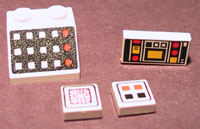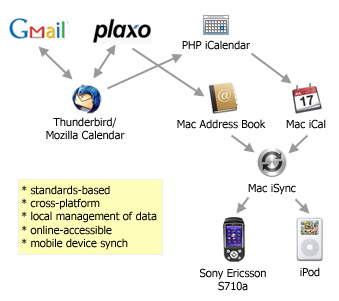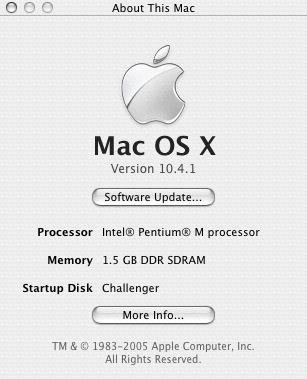There’s got to be a better way

For me these days it seems that the task of creating a presentation is really an act of merging and culling prior presentations, then creating new material to stitch it all together. Powerpoint is awful at this. What’s really needed is a way to view multiple presentations (trying … hard … not … to … say … “decks”) in a single window with all available slides so that you can mix and match and group. Sort of like the thumbnail view but with the flexibility to arrange stuff non-linearly. I don’t think Keynote does this either. I end up printing it all out and arranging on the floor. The GTD people surely love this low-tech information design, but I’m not convinced software couldn’t solve the problem (and free up my kid’s play area floor space)
Tinderbox for Windows where are you?
Yep, he’s a geek
I had the chance to steal Nicholas Negroponte’s laptop last night. I chose not to. He put it down for only a second.
We were on the same flight from Chicago to White Plains and, just as you’d suspect, his nose was buried in a laptop from the moment I spotted him in the gate area, through check-in, down the jetway into his seat — pause for takeoff, nervously — back on the whole flight — pause for landing, grumpily — balance on palm and back into it off the plane, into the baggage area. He actually made his chaffeur stand there, bags draped off him, while he did something on his laptop, still balanced on his left palm. What the hell was he doing? Surfing? Not typing, certainly. Being … digital?
(Actually I think he was working on this.)
iPod concerns
Dear Apple, I have some questions for you.
First, did you just break every gadgety add-on ever created for the iPod by removing the extended headphone port at the top? I’m not sure who you’ve pissed off more, your customers or companies like Belkin and Griffin. (Update: if that doesn’t irk ’em, this will.)
Also, what the !@$%&? happened to the 80GB iPod? We know you bought the big hard drives from Toshiba. What are you using them for?
Lastly, so you’re giving us rights-managed video and disallowing us from burning to CD/DVD? Must we submit a urine sample too?
C’mon, give me some love here! Please. I want to give you more of my money, but you are not making it easy.
Your friend,
John
PS – Front Row only for new iMacs? You think we PowerMac owners didn’t need this about two years ago?
Social voicemailing
Recently my office switched over to VoIP telephony. Cool enough, but the best thing about it is that I can finally check voicemail online without picking up the phone. Voicemail queues up on a website as WAV files. I periodically download them to a local folder that feeds into iTunes and is tagged as Voicemail. A local colleague* recently noted he could access my voicemail via iTunes since I was sharing my music library. This gave me an idea. Why not share voicemail with trusted colleagues on your local LAN? Or, better yet, podcast it? Here’s how my message would change:
“Hi, you’ve reached John Tolva with IBM. I probably will not return your call, but you should know that many of my office colleagues will have access to any questions you might have. They may even provide answers. Thank you.”
This could be big. Social voicemailing.
[*] The same colleague from this post. I found him!
The evolution of the LEGO computer block
Recently we’ve been sifting through about six tubs of LEGO bricks that I grew up with and still own. It has been an archaeological dig through my past. Not only is it fun to find certain blocks I used to love, but I’ll often come across some aborted or half-destroyed creation and I’ll almost instantly (and quite eerily) remember why I built it or what corner of my LEGO universe it occupied. This is from two decades ago, mind you. But the real treasure in this dig are the non-LEGO items buried in the brick-silt. Small, fractured toys, leaked batteries (and their dried acid), dessicated food stuffs, and all manner of childhood jetsam probably make up 5% of the brick tubs. Your hands become visibly dirty after running them through the tub for just five minutes. But even the scum tweaks nostalgia a bit.
I’ve recently discussed The coolest LEGO brick ever. During the latest excavations I made it a point of picking out all the computer-type bricks I could find. Here’s what I found.

First, the classics, in two versions. There’s the command line terminal on the left and the flashy-button sci-fi bleep-bloop box on the right. No one ever knew what that one did, but it flashed and bleeped and it seemed right at home on the launchpad. The evolution of the colors is the interesting thing in how it roughly sketches the evolution of real case colors. The earliest blue computers derived from spaceships and command bunkers, evolved into the beige-box ubiquity of the IBM PC era and thence to the whites of the post-iMac world.

The special find was this version of the command line model. It is inverted so that it hangs above the minifig user. Because, as is obvious, computers that you dangle over your head mean that you have a lot of screens to keep track of and that you are, thus, supercool.

In the LEGOverse computers seem to have taken a step backwards after the golden age of space-inspired computer blocks. At least the early machines had screens. This lot of button panels seem like a throwback to analog days. Not sure what to do? Press the red button.

‘Course, sometimes you needed the big iron. Here’s the only LEGO mainframe with removable front plate that I know of.
And lastly, assorted bricks that belong to what you might call targetting computers. The one on the right actually lit up when attached to a battery. Still not as cool as the classics, but in their vectory goodness they echoed Battlezone, flight sims, and other important arcade games of the era.

At this point I thought I pretty much had the complete evolution of LEGO computer bricks documented — at least up to the point that LEGO sets and themes diversified to the point of incoherence. (What in the hell is Bionicle?) But I should have known better. LEGO geeks have done a far more thorough job of documenting computer bricks than I ever could. But hey, even the best archaeologists only confirm what’s already known, right?
Mac nano
First things first. I didn’t receive a cease-and-desist from Apple. I took down the original post about getting OSX Tiger to run on an Intel-based laptop because I, you know, panicked. Not sure why I did that, but then Katrina came and life got nutty for a while and you all must have thought I had been arrested, fired, or sent to geek nirvana. Or all three. But no.
(You’ll never know if this is Photoshopped, will you?)
So here’s how it works. The laptop has two 60GB physical drives. One is partitioned into NTFS for XP and FAT32 for data files. The other has Mac OS on it. The PC is running MacDrive so it can see the HFS volume, but almost all working files reside on the FAT32 partition so that both OS’s can access them. At startup I just specify the drive to boot from (default is Windows for now). Nearly everything in Mac OS works — even crazy stuff like Bluetooth and 1600 x 1200 resolution. It is astonishing. Having a portable Mac that also boots to a real version of XP is life-changing, I tell you.
So while this is all happening out comes the jaw-dropping iPod nano to replace the iPod mini. You have to wonder if the same thing will happen to the Mac mini. And then you have to wonder, how long before doing what I do — carrying around a stealth copy of Mac OS inside (or alongside) a working PC — is something Apple encourages. Sure, I could have installed Mac OS on my iPod and could boot from that, which would be pretty much a Mac nano, but with perfect driver support and updates a real Mac nano would be unstoppable.
Think of it, Apple equips certain iPod models with a full version of Mac OS for Intel so that when they are connected to a PC you can boot to it and convert your PC to a Mac right then and there. What a better way to steathily convert PC users — not by having them buy a new machine but by taking over what they already own. Problem is, Apple does not want to do this. They’ll put iTunes on a Motorola phone, but not OSX on a non-blessed Intel chip. Sigh.
PIM system, now with pretty icons

What’s missing? It isn’t a perfect solution. Here’s what would make it so.
– Faster Mozilla Calendar with functional equivalence to Outlook’s calendaring.
– Full integration of calendar functionality into Thunderbird. (This is underway in the Lightning project, as I mentioned below.)
– Some way of moving sent and saved e-mail from years past into the Gmail environment without just mass-forwarding it all.
– Stable auto-publish of changes in Mozilla Calendar. Right now auto-publish eventually corrupts the data file locally and on the server. I have to manually publish. Shouldn’t be that way.
– Robust PC-based phone synching. Right now I’m going from PC to online to Mac to phone (and iPod). This is easy but needlessly complex.
– Two-way synch between Mac Address Book and Plaxo, just ’cause.
Outlook detox

Been a little quiet around these parts. Two reasons. I’ve been battling a mutant sinus virus that caused a skull-crushing headache and a high-pitched ringing in my ears that still hasn’t completely gone away. (Sonically isolating myself in a float tank probably didn’t help, I admit in hindsight.) But really the blog went quiet because I was in the middle of a project that knocked my world completely off-kilter: changing personal information management software.
I’m no fan of Microsoft, but I have been saying for years that they actually got it right with Outlook. I’ve used Outlook on my primary machine (a PC) as a standalone PIM and e-mail client since 1998 and have loved it. But I’ve known for probably a year that I had to wean myself. Here’s why:
– Non-standard data formats. Moving your information from Outlook to anything else requires third-party software and a masochistic tolerance for inaccurate field mappings and system freezes. I can’t stand having such critical data in a proprietary format, especially one controlled by MS.
– There’s no easy way to view data on multiple platforms. And no easy way to view data, replicate it, or back it up online (since I don’t use Exchange).
– I’m completely enamored with Mozilla Firefox and the extensions to it from the open source development community. Thunderbird and Sunbird were calling me.
Moving off of Outlook was pure hell.
I decided I was going to tackle Thunderbird first. I had to extract several year’s worth of e-mail with attachments using a variety of filters and applications (Outlook2vCal and Outlook2Mac) to create mbox files. This was the least painful part of the transition and it took me days. Thunderbird isn’t quite as elegant as Outlook, but it is damn close and the extensions for it are superb. I route through Gmail now using POP forwarding so, in essence, I have online replication too. Thunderbird also integrates with Plaxo, the online contacts management service, so I have online replication there too. E-mail transition happiness: 99%.
Next up, calendar. Suffice to say that getting meaningful appointment data out of Outlook is tragicomedy. As in, one must laugh in order not to cry. I imported the data in Sunbird only semi-successfully. Sunbird left me wanting, though. It is not as mature or stable as Firefox or Thunderbird. So I took a completely different tactic, moving all my calendar and task data to Yahoo! This was an interesting experiment that ultimately failed. I like Yahoo! Calendar a lot, but after using it exclusively for a few days I knew I need a desktop calendar app too. The web just isn’t the best medium for sustained calendar manipulation. (Though an AJAX-powered calendar would probably be usable. Listening, Google?) Also, Yahoo! Calendar only replicates with Outlook. And I wanted to eradicate Outlook completely.
Back to Mozilla. I switched from Sunbird to Mozilla Calendar because it was slightly better integrated with Thunderbird. I got the data in relatively cleanly. I learned more about the iCal format that Moz uses and then stumbled upon PHP iCalendar, a truly amazing web calendar viewer that actually has a better interface than even Outlook. So, though there’s no synching per se, I could publish/backup from MozCalendar to the web. But the best part is the iCal standard. Once I found iCalShare and subscribed to all kinds of calendars, I was off and running. I also subscribed the iCal app on my Mac to the published calendar file. I should have known that, per usual, Apple’s calendar was by far the easiest and most elegant solution available. But since I have a PC laptop it couldn’t be the only one. Sounds complicated, but it really isn’t:
– Mozilla Calendar is used to create and edit all appointments and tasks. It publishes the data to a webserver.
– PHP iCalendar allows viewing (but not editing) of this data online. It also provides RSS feeds for day, week, and month views and clean printer-friendly page layouts.
– The Mac iCal app subscribes to the published file online and so allows “replication” across multiple platforms. This replication is one-way. I don’t push changes back up. (There’s a nifty little AppleScript, iCal Calling iTunes!, that lets you schedule playlists to begin and end at certain times. Great for falling asleep to continuous streams, like the Sleepbot Environmental Broadcast.)
– Various other calendars (US Holidays, NASA events, Chicago events, etc.) are overlaid on my personal calendar data in each of the views.
Mozilla Calendar is slow and clunky, but it has a lot of promise and the feature set points in the right direction. I figure I am making a down payment in diminished usability (compared to Outlook) for the potential for functional and usability payoffs later on. The Lightning integration project is cause for optimism. Calendar transition happiness: 85%.
What about synching to the phone? Ack! There really is no good Thunderbird-to-phone app available. Mobile Master makes a valiant effort, but it sacrifices elegance for comprehensiveness. My phone, a Sony Ericsson S710a, supports syncML — but not much else does. There’s Mobical.net — a service for synching an online calendar with a phone over the cell network. It is a very cool idea, but of course it cuts out the desktop app and that’s a deal-breaker for me. And how often would you really need remote synchronization? Mac to the rescue again. Since my calendar data is subscribed on the Mac and since Plaxo exports to the Mac Address Book I use iSync to send data to my phone and to my iPod. Again one-way. (No more need for the PC iPodSync, a good program but one that’s also tied to Outlook.) Mobile device support transition happiness: 75% (due to a lack of PC-to-phone synch).
The only thing really missing from my new set up is some way to manage the hundreds of Note scraps I collected in Outlook. I played around with Tada List and Backpack and while they are super-usable they also limit you to only a few entries in the free version and they don’t synch with any kind of desktop application. Yahoo! Notepad synchs, but only with Outlook. I’m sure something exists. Just haven’t looked hard enough.
I’ve settled into the new tools now. The tremors have subsided and I think I am Outlook-clean. ‘Course it didn’t help that this whole migration was a subset of a much larger transmogrification of my PC into a more Mac-like, open source software animal. In the past few months I have installed TopDesk (an Expose clone), ObjectDock (a Mac dock clone), Xpize (an XP DLL refresher), and the OpenOffice.org suite. The only Microsoft app I am currently using is the OS itself. A significant one to be sure, but the Linux migration of my laptop — if it ever happens — is the subject of a future blog post.
Forget brain radiation

Yikes! Three possibilities come to mind.
(1) The phone itself makes you more likely to get hit. (But what cellphone today has a significant enough amount of metal on it?)
(2) Lightning bolts can follow the invisible paths of cellular radio signals right to the handset. That’d make a great urban legend.
(3) Standing under this tree using a cellphone makes you more likely to get hit. But then why this tree? (There were other signs around following no discernible pattern.)
Seems to me that it must have something to do with the phone being on, otherwise why note anything?
This reminded a colleague of mine of a story of a woman in a park in London killed when lightning struck her bra underwire. Only one way to prevent that, I think. Be safe, ladies.
“Heresy” after a decade
Ten years ago I wrote a paper for a small graduate school conference that in retrospect marked a real turning point in my life. The Heresy of Hypertext: Fear and Anxiety in the Late Age of Print was a bit of a personal manifesto, an attempt to bring my literary critical skills (my day job) to bear on the new media of hypertext (what I obsessed about most of the rest of the time). But, in truth, it was actually an extended rant to my English grad school professors about the importance of hypertext and digital text. Great scholarship “Heresy” wasn’t — and oh my how saturated it is in gradschool-speak neologisms! — but it is still the most linked-to part of any site I have ever had. It has even been anthologized and translated.
But ten years is a long time when you’re writing about new media. Let’s see how it holds up.
Just as bibliographers regard 1501 as the year that printed books emerged from the “cradle” of their post-Gutenberg nativity, the first year of the coming millennium will likely serve as a convenient demarcation point for the end of the beginning of electronic textuality.
True enough. By 2001 blogging was in full swing, putting to rest any notion that the written word and electronic media were somehow incompatible. Though literary hyperext was not a mainstream phenomenon in 2001 (and is not now) I think it is fair to say that by 2001 most would agree that electronic textuality had matured to the point where the distinction between it and the printed word was largely academic — a sure sign of cultural assimilation.
Though this new textuality promises to level hierarchical distribution of and access to even the most esoteric data, we should not make the mistake of equating the leveling with a reduction in the standards of professional scholarship. In fact, in such an intraloquial and interactive scenario, shoddy work quickly draws attention to itself, succumbing to the necessarily higher standard of excellence in a web of virtual collaborators and competitors.
Mostly true. Wikipedia is a great example of this kind of collaborative weeding-out of shoddiness. A web of casual editors does expose deficiencies in rigor and quality faster than in other media. But the very anonymity, publishing reach, and fungibility of electronic text also makes fraud a hell of a lot easier.
To the mind weaned on the indelibility of the printed word, electronic text seems unstable, less epistemologically graspable. I submit that this mostly unconscious perception of instability generates anxiety in the reader, anxiety of the type usually written off to the “it just feels different” category.
I think I missed on this one. Perhaps it was true in 1995, but I’m now of the opinion (largely because of Matt’s work) that the immateriality/instability was an illusion. The “just feels different” aspect, I suspect, was mostly a function of screen resolution.
Not a bad little paper, after all. Overwrought to be sure, but a personal milestone and one that I will always look to as the springboard that launched me into the arc that I am still on.














